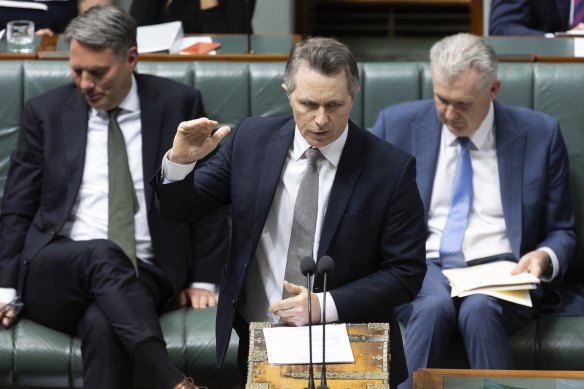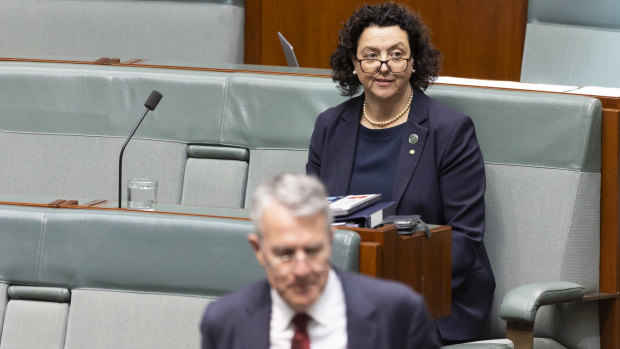Labor wipes $3b off student loans as cost-of-living relief measure
By Paul Sakkal
A total of $3 billion will be wiped off millions of Australians’ student debts for tertiary education in an Albanese government pitch to younger voters punished by years of rising rents and consumer prices.
Facing Greens and crossbench blowback on its agenda to help financially insecure Millennials, the government has revealed a major change to the calculation of student loan indexation to save the average graduate $1200 on their total debt.

Education Minister Jason Clare.Credit: Alex Ellinghausen
The $48.5 billion worth of loans are indexed once a year and pegged to inflation, which rose by a once-in-a-generation 7.1 per cent last year and remains high, fuelling concerns that young people are being held back from securing mortgages due to their large student fee loans.
The inflation spike increased the size of many students’ debts by thousands of dollars each, prompting Education Minister Jason Clare to intervene by tying indexation to whichever figure is lower out of national wages growth or the consumer price index. This change was recommended by a major university sector review.
“We are doing this, and going further. We will backdate this reform to last year. This will wipe out what happened last year and make sure it never happens again,” Clare said in a statement on the announcement, part of the federal government’s budget to be handed down on May 14.
“This will wipe out around $3 billion in student debt from more than three million Australians.”
The government will retrospectively lower the indexation figure paid by students on June 1 last year from the inflation figure of 7.1 per cent to the wage growth number of 3.2 per cent. The figure for the upcoming indexation in June is also being lowered.
A student with the average debt of $26,500 will receive a credit worth $1200. For a student with a large debt of $130,000, the saving will be close to $6000.
Minister for Skills and Training Brendan O’Connor said: “By backdating this reform to last year, we’re making sure that apprentices, trainees and students affected by last year’s jump in indexation get this important cost-of-living relief.”
Australia’s university fee program – known as HECS when it launched in the 1980s and since renamed HELP – is widely viewed as a successful scheme that has allowed many Australians to gain degrees and increase earning capacity.
The scheme forces students to pay only when their income meets a certain threshold.
But student advocates, crossbench MPs and experts have recently questioned the fairness of the scheme as universities increased fees and inflation spiked, causing indexation to jump.
Independent MP Monique Ryan – a member of the cohort of teal MPs who were heavily backed by younger voters in their former Liberal electorates – gathered 270,000 signatures on a petition to modernise the student loan system.
She said last month that a person on a $60,000 salary with a $25,000 outstanding debt would have seen their debt grow by about $1200 if it was indexed to inflation in the middle of this year.

Member for Kooyong Dr Monique Ryan.Credit: Alex Ellinghausen
“Yet over the past year, they will have paid off only $1200. In other words, hundreds of thousands of Australians with a HECS debt are either treading water or seeing their HECS debts increase despite working hard to pay them off,” she said. “This is untenable.”
Economics professor Bruce Chapman, a founder of the HECS system, said it was unprecedented for a government to wipe debt retrospectively.
“However, this will not change how much a graduate pays in any given year or period because repayments are levied as a proportion of a person’s income,” he said.

Australian National University economics professor Bruce Chapman.
Chapman said the move would have the effect of lowering the size of a person’s loan and therefore decreasing the amount of time it would take to pay off their debt, which effectively operates as a levy on income. For example, he said a person who might be on track to pay their debt off in a decade might now be able to do so six months earlier.
Chapman said there had been a lot of anxiety in the community about the 7.1 per cent indexation last year, leading to widespread media coverage and political pressure on Labor.
It was rare that inflation ran at a significantly higher rate than wages growth, he said, meaning Labor’s change to the indexation calculation was unlikely to be as meaningful in future years as it was during the recent inflation outbreak.
“I think this will be welcomed, and it’s a politically astute move,” he said.
In another Albanese government announcement ahead of the May 14 budget, Finance Minister Katy Gallagher revealed Labor had found $1 billion in savings from cutting the use of consultants and contractors.
The saving comes on top of $3 billion of future external labour spending cut by the government last year.
Cut through the noise of federal politics with news, views and expert analysis. Subscribers can sign up to our weekly Inside Politics newsletter.